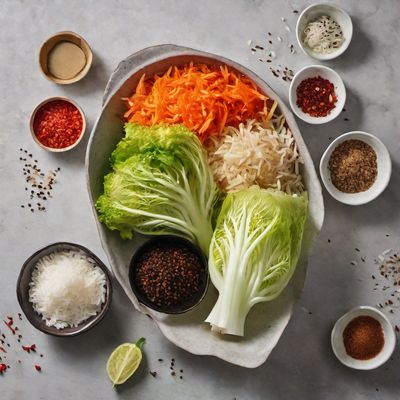
Recipe
Turkish-style Kimchi
Spicy and Tangy Turkish Kimchi Delight
4.8 out of 5
In Turkish cuisine, bold flavors and vibrant spices are celebrated. This adaptation of the traditional Korean dish, kimchi, brings together the best of both worlds. Turkish-style Kimchi is a fiery and tangy fermented cabbage dish that will add a burst of flavor to any meal. Get ready to tantalize your taste buds with this Turkish twist on a Korean classic.
Metadata
Preparation time
20 minutes
Cooking time
0 minutes (fermentation time: 2-3 days)
Total time
2-3 days (including fermentation time)
Yields
4 servings
Preparation difficulty
Easy
Suitable for
Vegetarian, Vegan, Gluten-free, Dairy-free, Low calorie
Allergens
Garlic, Fish (if using fish sauce)
Not suitable for
Nut-free, Soy-free, Paleo, Keto, Low-carb
Ingredients
While the original Korean kimchi is known for its intense spiciness and pungent aroma, Turkish-style Kimchi incorporates Turkish spices and flavors to create a unique fusion. The Turkish version may include ingredients like sumac, Aleppo pepper, and pomegranate molasses, giving it a distinct tangy and slightly sweet taste. We alse have the original recipe for Kimchi, so you can check it out.
-
1 large head of cabbage, shredded (about 1.5 kg / 3.3 lbs) 1 large head of cabbage, shredded (about 1.5 kg / 3.3 lbs)
-
2 tablespoons sea salt 2 tablespoons sea salt
-
2 tablespoons sumac 2 tablespoons sumac
-
2 tablespoons Aleppo pepper flakes 2 tablespoons Aleppo pepper flakes
-
2 tablespoons pomegranate molasses 2 tablespoons pomegranate molasses
-
4 cloves garlic, minced 4 cloves garlic, minced
-
1 tablespoon ginger, grated 1 tablespoon ginger, grated
-
2 tablespoons fish sauce (optional for non-vegetarian version) 2 tablespoons fish sauce (optional for non-vegetarian version)
-
2 tablespoons olive oil 2 tablespoons olive oil
-
2 tablespoons water 2 tablespoons water
Nutrition
- Calories (kcal / KJ): 80 kcal / 335 KJ
- Fat: 3g (Saturated Fat: 0.4g)
- Carbohydrates: 12g (Sugars: 6g)
- Protein: 3g
- Fiber: 4g
- Salt: 2g
Preparation
-
1.Place the shredded cabbage in a large bowl and sprinkle with sea salt. Massage the salt into the cabbage for about 5 minutes to help release its juices.
-
2.Rinse the cabbage under cold water to remove excess salt. Drain well and transfer to a clean, dry bowl.
-
3.In a separate bowl, combine the sumac, Aleppo pepper flakes, pomegranate molasses, minced garlic, grated ginger, fish sauce (if using), olive oil, and water. Mix well to create a paste.
-
4.Pour the paste over the cabbage and mix thoroughly, ensuring all the cabbage is coated.
-
5.Transfer the mixture to a clean, sterilized jar, pressing it down firmly to remove any air pockets.
-
6.Close the jar tightly and let it sit at room temperature for 2-3 days to allow fermentation to occur. After this initial fermentation period, refrigerate the kimchi to slow down the fermentation process.
-
7.Turkish-style Kimchi is ready to be enjoyed! Serve it as a side dish or use it to add a burst of flavor to your favorite Turkish dishes.
Treat your ingredients with care...
- Cabbage — Make sure to thoroughly wash and dry the cabbage before shredding it to remove any dirt or impurities.
- Sumac — Use high-quality sumac for the best flavor. If you can't find sumac, you can substitute it with lemon zest for a similar tangy taste.
- Aleppo pepper flakes — If you can't find Aleppo pepper flakes, you can use a combination of paprika and cayenne pepper for a similar level of spiciness.
- Pomegranate molasses — Look for pomegranate molasses in Middle Eastern or specialty stores. If unavailable, you can make your own by reducing pomegranate juice until it thickens.
- Fish sauce — Fish sauce adds depth of flavor, but it can be omitted for a vegetarian version.
Tips & Tricks
- For a milder version, reduce the amount of Aleppo pepper flakes.
- Allow the kimchi to ferment for longer if you prefer a stronger and more tangy flavor.
- Use a clean and sterilized jar to prevent unwanted bacteria from contaminating the kimchi.
- Serve Turkish-style Kimchi chilled for a refreshing and tangy experience.
- Experiment with adding other Turkish spices or herbs to customize the flavor to your liking.
Serving advice
Serve Turkish-style Kimchi as a side dish alongside grilled meats, kebabs, or rice dishes. It also pairs well with Turkish flatbread or pita bread.
Presentation advice
Transfer the Turkish-style Kimchi to a decorative serving bowl or plate. Garnish with a sprinkle of sumac and a drizzle of olive oil for an appetizing presentation.
More recipes...
For Kimchi » Browse all
For Korean cuisine » Browse all
More Korean cuisine dishes » Browse all

Daegujeon
Fried cod
Daegujeon is a traditional Korean dish that is made with breaded and fried fish. It is a popular dish that is often served as an appetizer or snack.

Oi bokkeum
Spicy Cucumber Salad
Oi bokkeum, also known as stir-fried cucumber, is a Korean side dish. It is made with cucumbers, garlic, and a spicy sauce.

Jeyuk bokkeum
Stir Fried Spicy Pork
Jeyuk bokkeum is a traditional Korean dish that is made with pork and vegetables. The dish is popular all over Korea and is often served as a main course.











